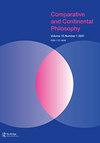Spinoza in German Idealism: Rethinking Reception and Creation in Philosophy
IF 0.3
0 PHILOSOPHY
引用次数: 1
Abstract
ABSTRACT It is a widely accepted idea that German Idealism stands on two pillars: Kant and Spinoza. The aim of this essay is to critically reflect on this way of understanding the history of philosophy through a study of the reception of Spinoza in the early writings of Fichte, Schelling, and Hegel. This analysis will show that each of them builds a different image of Spinoza that is not based on the scholarly study of his works, but rather deeply conditioned by other readings and controversies of the time. Each assigns a central role to that image of Spinoza in the justification of his own system, and in each case that theoretical function is different: Spinoza is viewed as an enemy (Fichte), a possibility and a source of inspiration (Schelling), and a model of true philosophy (Hegel).德国唯心主义中的斯宾诺莎:哲学接受与创造的再思考
摘要德国唯心主义有两大支柱:康德和斯宾诺莎,这是一个被广泛接受的观点。本文旨在通过对费希特、谢林和黑格尔早期著作中对斯宾诺莎的接受的研究,批判性地反思这种理解哲学史的方式。这一分析将表明,他们每个人都构建了一个不同的斯宾诺莎形象,这不是基于对其作品的学术研究,而是深受当时其他阅读和争议的影响。在为自己的体系辩护时,每个人都为斯宾诺莎的形象赋予了核心作用,在每种情况下,理论功能都是不同的:斯宾诺莎被视为敌人(费希特)、可能性和灵感来源(谢林),以及真正哲学的典范(黑格尔)。
本文章由计算机程序翻译,如有差异,请以英文原文为准。
求助全文
约1分钟内获得全文
求助全文

 求助内容:
求助内容: 应助结果提醒方式:
应助结果提醒方式:


